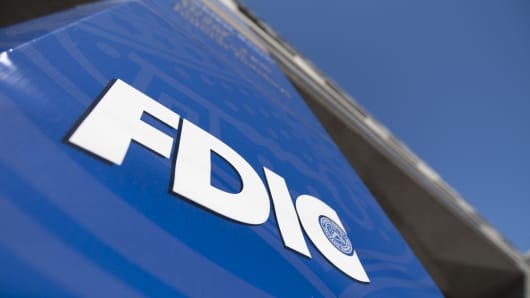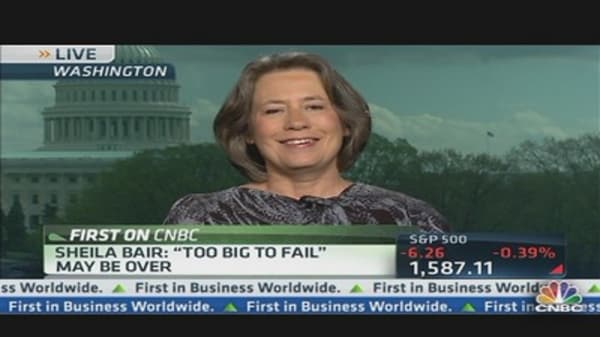Moody's Investors Service said last month that it may downgrade some bank bonds by year-end, as the U.S. appears less likely to bail them out. The agency has assigned a negative outlook on bonds from JPMorgan Chase, Bank of America, Citigroup, Wells Fargo,Goldman Sachs and Morgan Stanley.
The evidence of the FDIC's persuasiveness is anecdotal at this point, as data on bank credit default swaps, used by investors to protect themselves against default, have not shown a clear shift.
But investors and analysts said they are studying how to price the heightened risk based on the FDIC's plan and expect to see more movement in the coming months.
"To get sophisticated investors to invest better, this is how you do it," said David Hendler, a senior analyst at CreditSights who hosted a conference with an FDIC official for investors. "You put more of their skin in the game."
(Read More: Citi Beats on Profit and Revenue; Shares Rise)
The debate over whether Washington has solved "too big to fail" will not be settled until another crisis tests whether U.S. and overseas stewards have the confidence and skill to gently take down a failing mega bank without triggering a crippling market shock.
Still, the FDIC's stand is that if markets know what to expect and stay calm when a financial giant gets into trouble, Washington will also be less likely to panic and enact another bailout, said people familiar with the agency's approach. The FDIC also hopes investors will be more likely to scrutinize mega bank activity, curbing risky activity if they are convinced that the era of government bailouts is over.
The FDIC declined to comment for this story.
The agency has posted on its website slide presentations it has used to show how it would exercise its liquidation authority.
Whose Haircuts
FDIC staff began hosting small gatherings and teleconferences in early 2012 with Wall Street to discuss the details and repercussions of a bank failure, such as what happens to subordinated debt, secured lenders and bridge financing, according to documents on the FDIC website.
Under the plan, the agency would take over the top-level holding company, which is usually owned by public shareholders and financed in part by bond investors. The FDIC would then use capital from the holding company to rescue failing subsidiaries, such as deposit-taking banks or trading arms.
(Read More: Pension Group Moves to Split JPMorgan Chairman, CEO Roles)
Shareholders of the holding company would be wiped out, and bondholders would be forced to take a haircut.
The FDIC could then form a bridge holding company, with new leadership most likely pulled from a list the agency is drafting of veteran bankers and others, according to a person familiar with the agency's plans.
James Campbell, a research analyst covering big financial companies for CalPERS, said the FDIC's plan to keep bank subsidiaries from insolvency would go a long way toward protecting depositers and reducing risks to the financial system.
Still, some investors who have met with the FDIC said significant issues must be resolved, such as how to deal with a failed bank's overseas subsidiaries, which are subject to foreign insolvency practices. Unless those concerns are addressed, subsidiaries' creditors would likely take their money back and feed a panic.
"There are too many connections that credit investors do not understand, so you just assume you need to sell not only the entity that is in trouble but everything that is connected to it," said David Knutson, a senior research analyst at Legal & General Investment Management, who has been to multiple FDIC presentations.
The FDIC released a report with U.K. regulators in December explaining how they would work together to resolve a U.S. holding company with London-based subsidiaries.
One person with knowledge of the FDIC's work said regulators now have a better understanding than before the financial crisis of the different laws, bank structures and other factors that could complicate the resolution of a global bank failure. The person called it a "transformational shift" in international dialogue.
'Living Wills'
The FDIC and the Federal Reserve have asked banks to draft so-called living wills to lay out how they could be dismembered if they suffered mortal losses.
The Office of the Comptroller of the Currency has also had some preliminary conversations with executives about how to simplify bank structures. In the last month, the OCC has discussed pushing big banks to assess how many subsidiaries they operate and how they are aligned, an agency official said.
That could eventually make it easier to sell off subsidiaries to help a bank recover from a downturn or to resolve a failed firm, said the official, who did not want to be identified as the early discussions are not public.
A workable FDIC liquidation plan could stave off political pressure for more drastic financial reforms following the 2010 Dodd-Frank law, such as calls to break up the big banks and legislation to limit bank size. These proposals may be long shots, but another financial blowup could spark the political will necessary to make them a reality.
"Some of us see it as the key to a safer financial system," said Wilson Ervin, a New York-based senior adviser to the CEO of Credit Suisse Group AG. "And some pragmatic types realize that if you don't have a solution to 'too big to fail,' then the regulations and restrictions will keep coming, and you won't really have a good argument to stop them."
Fed Gov. Daniel Tarullo has said the central bank may require some bank holding companies to issue minimum levels of long-term debt. The idea is to make sure they have enough obligations to slash for the FDIC to recapitalize a failing business. But a minimum could force some banks to use costlier forms of borrowing and even pressure them to sell off parts of their business.
"It creates market pressure to downsize," said former FDIC Chairman Sheila Bair. "That's what it means to end 'too big to fail.' It's a good thing, not a bad thing, that their funding costs go up."
The Fed has said settling the minimum debt issue is an agency priority this year.
Darrell Duffie, a finance professor at Stanford University's business school, said regulators are making progress toward resolving the challenges of shutting down a mega bank.
"There are still a few missing pieces to the puzzle," he said. "With some work over the next years, I think there is going to be a significant improvement in the ability to allow banks to fail."




